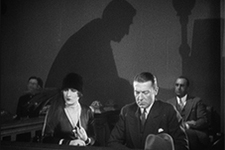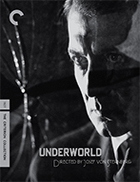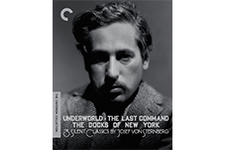Underworld
|  Josef von Sternberg’s Underworld, which was released to great acclaim and box office success in 1927, the year in which synchronized sound began its dominance of Hollywood, is frequently cited as the first modern gangster film, the progenitor of the controversial early-’30s triumvirate of Little Caeser (1930), The Public Enemy (1931), and Scarface (1932). Although the film lacks many of the later gangster films’ most important elements, particularly references to bootlegging and, of course, the clearly ethnic accents of the gangster antiheroes, virtually everything else about it was ahead of its time. There had been gangster films before—notably D.W. Griffith’s 1912 one-reeler The Musketeers of Pig Alley—many of which were shot in New York City’s slums and featured real-life criminals as extras, but Underworld was the first to make art out of the genre, with von Sternberg bathing the screen in expressionistic shadows and displaying an impressive grasp of montage editing to heighten the impact of on-screen violence. The result is a brilliantly executed criminal melodrama that helped set the stage for one of Hollywood’s most notorious genres. Although not explicitly set in Chicago, the story for Underworld was originally concocted by Chicago journalist-turned-screenwriter Ben Hecht, who derived some of his ideas from the Cicero and South Side mobs in the Windy City, which the unnamed critic at Variety noted in the first line of his or her review. This was typical of silent-era crime films, which tended to tell stories literally “ripped from the headlines” with only minor changes in names and dates, and Underworld, despite being largely fantastical in conception, is awash with small touches that connect it to real-life events, such as the gunning down of a gangster in a flower shop, which audiences at the time would have immediately connected with the similar slaying of Chicago mobster Dion O’Banion three years earlier. Underworld’s main character is a former lawyer-turned-alcoholic bum (Clive Brook) who one night happens across a bank that is being single-handedly robbed by the infamous gangster Bull Weed (George Bancroft). Bull Weed decides to take the bum under his wing; he rechristens him Rolls Royce and puts him to work, first cleaning up at the Dream Café, the saloon where all the gangsters hang out, and later as his personal assistant and second-in-command. It is in this capacity that Rolls Royce crosses paths with Feathers McCoy (Evenlyn Brent), Bull Weed’s dynamic and flirtatious “moll,” leading to a love triangle in which various loyalties are tested when Bull is sent to prison for murdering a rival gangster who tried to rape Feathers, thus freeing her and Rolls to pursue the feelings they had previously needed to repress. The story, which was adapted from Hecht’s initial 18-page outline by Charles Furthman and then scripted by Robert N. Lee, is fairly flimsy, melodramatic material set against the backdrop of organized crime, but it works well enough, especially given the strong performances by George Bancroft, whose grinning, swaggering bluster has a way of morphing from the genial to seething rage; Clive Brook, whose character is almost entirely internal, yet deeply expressive; and Evenlyn Brent, who plays up Feathers’ flapper-era independence while also conveying a genuine emotional longing. However, it is von Sternberg’s visual style and the art direction by German émigré Hans Dreier (the entire film was shot on studio sets) that elevates Underworld into something more than a run-of-the-mill crime picture. Although hardly as baroque as his later films with Marlene Dietrich, von Sternberg was clearly a student of both German expressionism and Soviet montage theory, as he employs both approaches with the kind of dexterity and aplomb that is more indicative of European, rather than American, silent cinema. Having made only two films previously, the independently produced The Salvation Hunters (1925) and the unreleased and now lost Charles Chaplin-produced A Woman of the Sea (1926), von Sternberg was looking for a way to meld his avant-garde sensibilities with studio material, and Underworld turned out to be the perfect vehicle. Even critics who didn’t think much of the film, such as The New Republic’s Louise Bogan, couldn’t help but be impressed by von Sternberg’s virtuoso aesthetics, especially his ability to convey complex action with only a few shots: “This kind of incisiveness,” she wrote, “this giving of the part for the whole, when used imaginatively, not spottily or as a trick, is a method exactly suited to the screen, and one little used.” Throughout the film von Sternberg is particularly fond of using shadows expressively, as when he frames Rolls Royce and Feathers at Bull Weed’s trial with the gangster’s massive shadow on the wall behind them, which both dominates them visually and reminds us that the man to whom they both owe so much is on trial for his life. This is counterbalanced with von Sternberg’s strong sense of how to use close-ups to emphasize emotions and break up the visual field. The film’s climax, which finds Bull Weed busting out of prison in search of his cheating girl and former friend, is awash with contrast and elliptical shapes that eventually give way to a frenetic editing rhythm when he is cornered in his apartment with machine-gun-wielding police outside (not surprisingly, von Sternberg described the film in his autobiography as “an experiment in photographic violence and montage”). The scene is strongly reminiscent of Tony Camonte’s cornering and ultimate demise in Scarface, although Underworld wears its underlying melodrama very much on its sleeve as Rolls risks his life amid a hail of bullets to prove his loyalty to Bull. Although couched in fairly realistic terms, virtually everything in Underworld is pure fantasy, a celluloid projection of popular conceptions of the gangster life, which may be its most important and lasting legacy.
Copyright © 2019 James Kendrick Thoughts? E-mail James Kendrick All images copyright © The Criterion Collection | |||||||||||||||||||||||||||||||
Overall Rating: 


 (3.5)
(3.5)


 Underworld is available exclusively via The Criterion Collection’s “3 Silent Classics by Josef von Sternberg” Blu-ray box set, which also includes The Last Command (1928) and The Docks of New York (1928).
Underworld is available exclusively via The Criterion Collection’s “3 Silent Classics by Josef von Sternberg” Blu-ray box set, which also includes The Last Command (1928) and The Docks of New York (1928). 